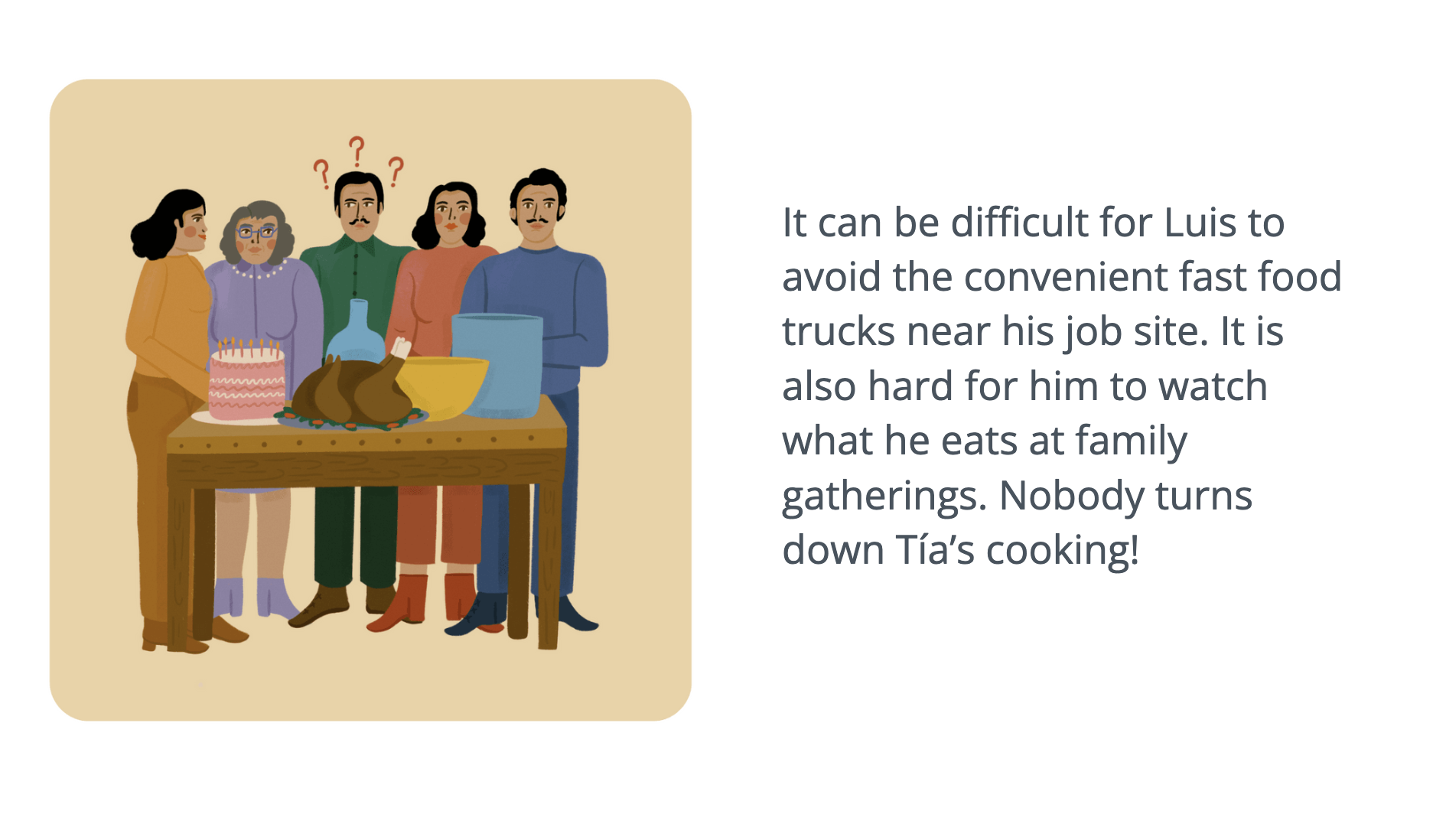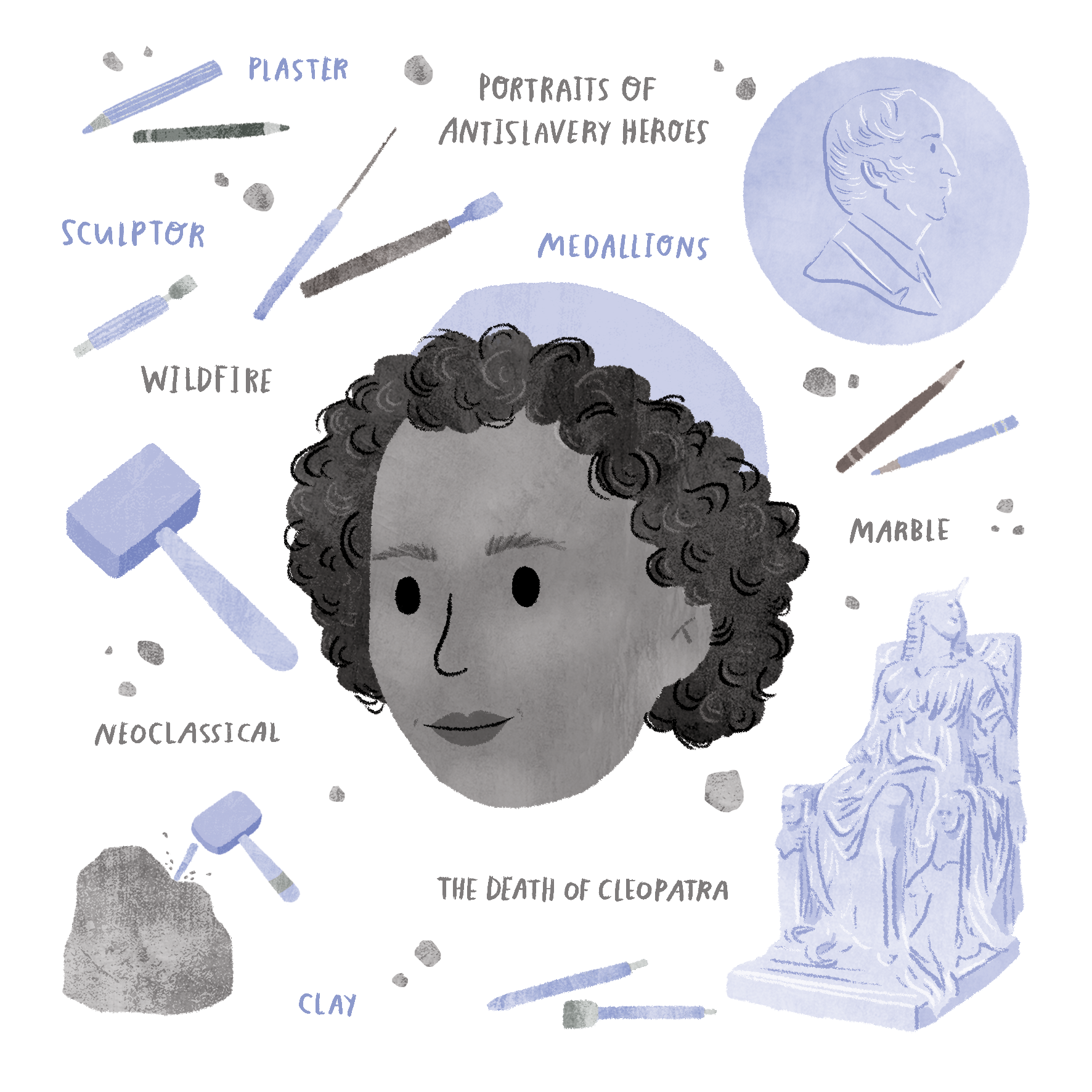I read parts of Dante’s Inferno in high school, I have seen bits and pieces of the Nutcracker during most holiday seasons, and I spent a lot of time reading quantum mechanics textbooks throughout my education.
Before the spring of 2018, I never thought that those three things could be combined. Yet, I spent most of that February and March thinking exactly about this unlikely combination! Week after week, I watched an art piece develop from a bold idea shared by two inter-disciplinary creatives, into a full-fledged theatre production. In the end, it involved a cast of actors, physicists, theater students and at least one Nobel laureate.
An unusual performance
This production, a multi-media performance piece called Quantum Voyages, told the story of multiple quantum physics phenomena and explored some of most famous systems from the field of condensed matter physics.

A cast of photons and Sapienza
The piece touched on more than one philosophical interpretation of quantum mechanics, introduced the idea of a photon as a particle-like packet of light, explored fundamental differences between particles that are classified as fermions and those classified as bosons, explained one of the physical mechanisms that can lead to perfect electrical conductivity, and gave a recipe for creating superfluids of ultracold atoms. Simultaneously it was a story about friendship, about following your curiosity and hanging out with mysterious strangers, about one fairly intense dance, and one really wild game of Clue.
When I agreed to be the Production Manager for Quantum Voyages, I knew that it would be a very different experience compared to research projects that made up my doctoral degree in theoretical physics. I didn’t know how rich and powerful it would be.
I watched Quantum Voyages premier sitting between its lighting and sound designers. I had just wished a happy eightieth to the famous physicist Sir Anthony J. Leggett. My thesis advisor, Prof. Smitha Vishveshwara, took the small stage in the center of a packed hotel ballroom and introduced the night’s narrative alongside her collaborator and devised theater maker Latrelle Bright. Physicists had flown-in from all parts of the country to celebrate Prof. Leggett by holding a conference, and now they were about to experience a very different celebration of some of the physics they shared. The play’s two protagonists, Terra (Earth) and Akash (Sky), stepped onto the stage and their journey started to unravel fast, with lots of colors and flashing lights.
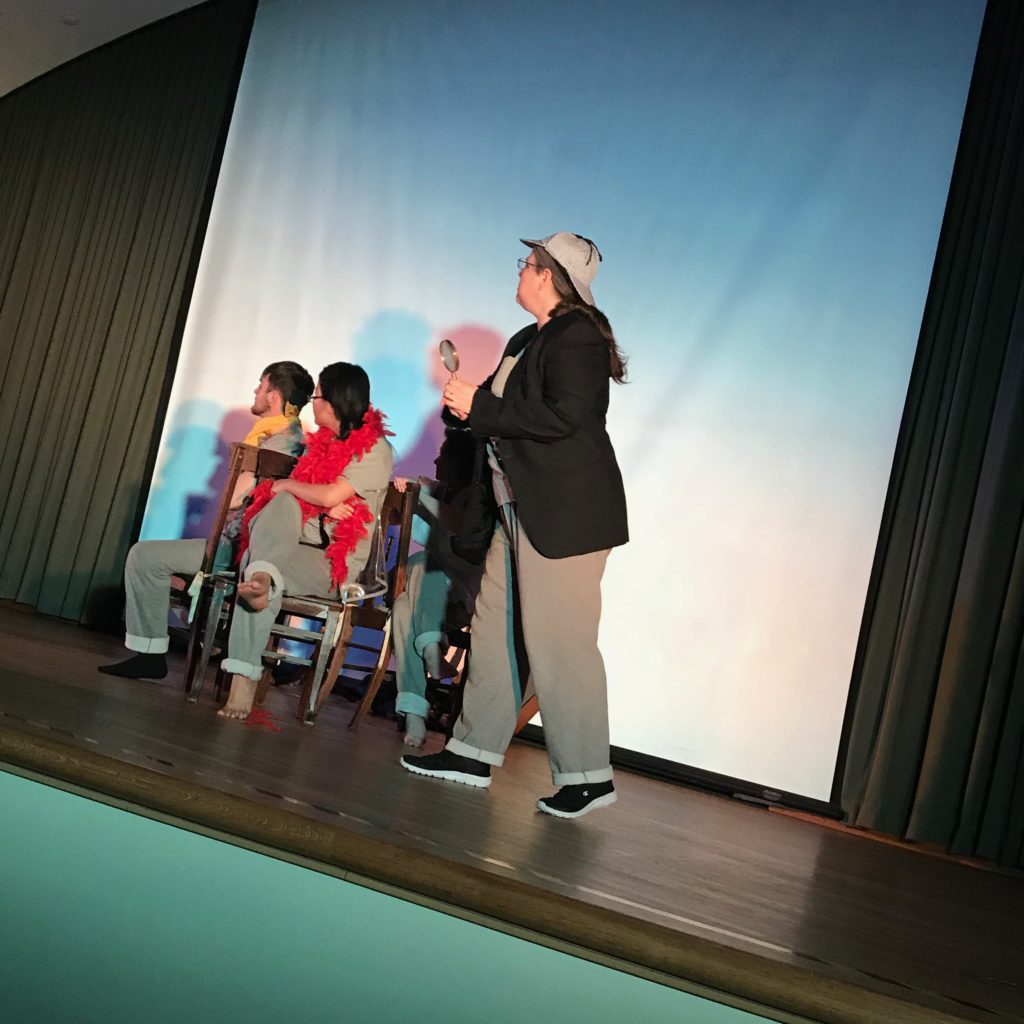
Detective Erwin during a game of Clue
Two friends journey through the quantum world
In Quantum Voyages, Terra and Akash (played by my friends and fellow physicists Gloria and Michael) meet a mythical figure named Sapienza – the spirit of knowledge – and together travel through various worlds that comprise the quantum world. First, they meet a literal crew of photons. A physics professor steps in from the audience to explain the nature of light in nothing short of iambic pentameter. Her stunning cameo foreshadows a series of guest-roles taken up by faculty members from the University of Illinois Urbana Champaign Department of Physics.
Next, a German-speaking detective, possibly the forefather of quantum mechanics Erwin Schrodinger himself, gives up on explaining the famous dead-and-alive cat thought experiment and tries to solve a non-deterministic murder instead. This makes for an unforgettable game of Clue, though no-one really knows who the murderer was at the end. Wide-eyed and slightly out of breath, Terra and Akash realize that the nature of reality is much more complicated than it seems.
Then, they surf the collection of highly energetic electrons in a metal that make up the so-called Fermi sea. It gets a bit rough and wavy, but our heroes make it out with just enough focus to start to argue. Their dispute? The common dilemma of whether one should try and understand the world by examining each of its little parts with the cold logic of a scientist or take it all in holistically, with the open heart and whimsy of an artist.
Bothered by having to choose, Terra wanders off and picks up an odd synchronized dance with some nearby atoms. She falls into a trance and collapses. Worried, Akash makes sure she gets all the medical support she needs, including getting her to an MRI. While she is unconscious inside the machine, he delivers a moving speech that highlights both how the MRI works and how much he misses her company.
Quantum Voyages technically concludes after Terra recovers and reconnects with her travel companion. However, their voyage really does not seem to end at all. In the last scene of the show, both characters have even more questions for Sapienza than they had at the beginning of their adventure. To everyone in the audience that first night, physicists and non-experts alike, it was clear that curiosity will take the two to many more worlds. Once Akash and Terra are done with whatever future physics adventure awaits, Dante will look like just a casual stroll enthusiast in comparison.
The journey makes an impression
I attended many rehearsals for Quantum Voyages. I helped design the props and I worked individually with the crew of physics and art, graduate and undergraduate, students that made the show happen. Naively, I thought I knew what to expect from it. When Terra, wearing sunglasses I had lent her and reclining on a chair I had personally carried across campus and onto the stage, uttered the first “What does it mean to see?” I mouthed it with her. I knew photons will enter next, my friend Daniel being one of them, my neighbor Tianhe another.
Almost unconsciously I kept track of overlaps between lessons in classes I have taught or taken and the plot of the play. I learned that two fermions “don’t like each other” i.e. cannot occupy the same quantum state in college; Akash and Terra learn it by fighting each other after almost drowning in a sea of them. I co-authored research papers concerning specific kinds of Bose-Einstein condensation; Terra took similar insights in through choreography. I wondered how someone who had not committed years of their life to studying physics like I had perceived all these adventures.
“It was almost like children’s theater”, a colleague told me when the show hit the road and saw a repeat performance at the American Physical Society March Meeting in Boston the following year. I couldn’t disagree with them. This was an adventure tale a child might find exhilarating much more than a traditional physics lesson. In many ways, this is why Quantum Voyages was so effective, and special, as a science communication project.
Storytelling is key
Prof. Vishveshwara had been teaching an interdisciplinary course named Where the Arts Meet Physics since 2016 and she had collaborated with Bright for a few years as well. In developing Quantum Voyages, the two had valuable experience. Most importantly, their work highlighted the importance of narrative when it comes to communicating science.
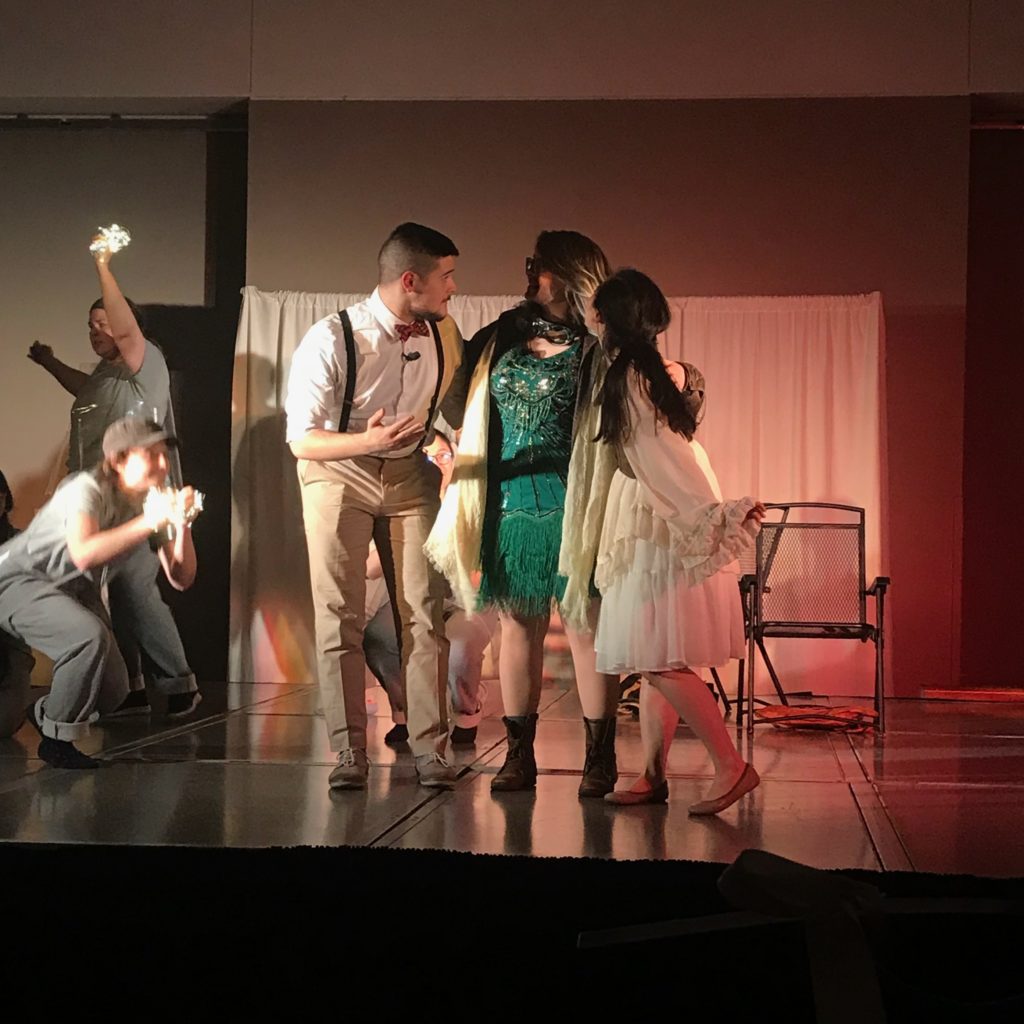
Akash, Sapienza, Terra discussing the quantum nature of light while photons approach them
The frame on which Quantum Voyages hangs is not revolutionary. It draws from classics such as the Nutcracker and mimics elements of the “hero’s journey” storytelling structure. What is revolutionary about it, however, is that it populates that frame with content otherwise found in advanced textbooks. The content of Quantum Voyages is intellectually challenging but the piece retains the excitement of an adventure story.
Not worrying about providing every rigorous definition or introducing jargon, Vishveshwara and Bright chose to submerge their audience in the quantum world. Such a full experience often does not result from solving equations or memorizing definitions. Each performance exposed the audience to a dynamic story about two friends who have lots of questions and open minds. They were there to watch them voyage rather than to explicitly learn. By getting invested in Terra and Akash, they would almost accidentally learn more physics than in any lecture. The compelling story allowed the physics to shine. It became a perk of hanging out with the protagonists rather than an intimidating course of study.
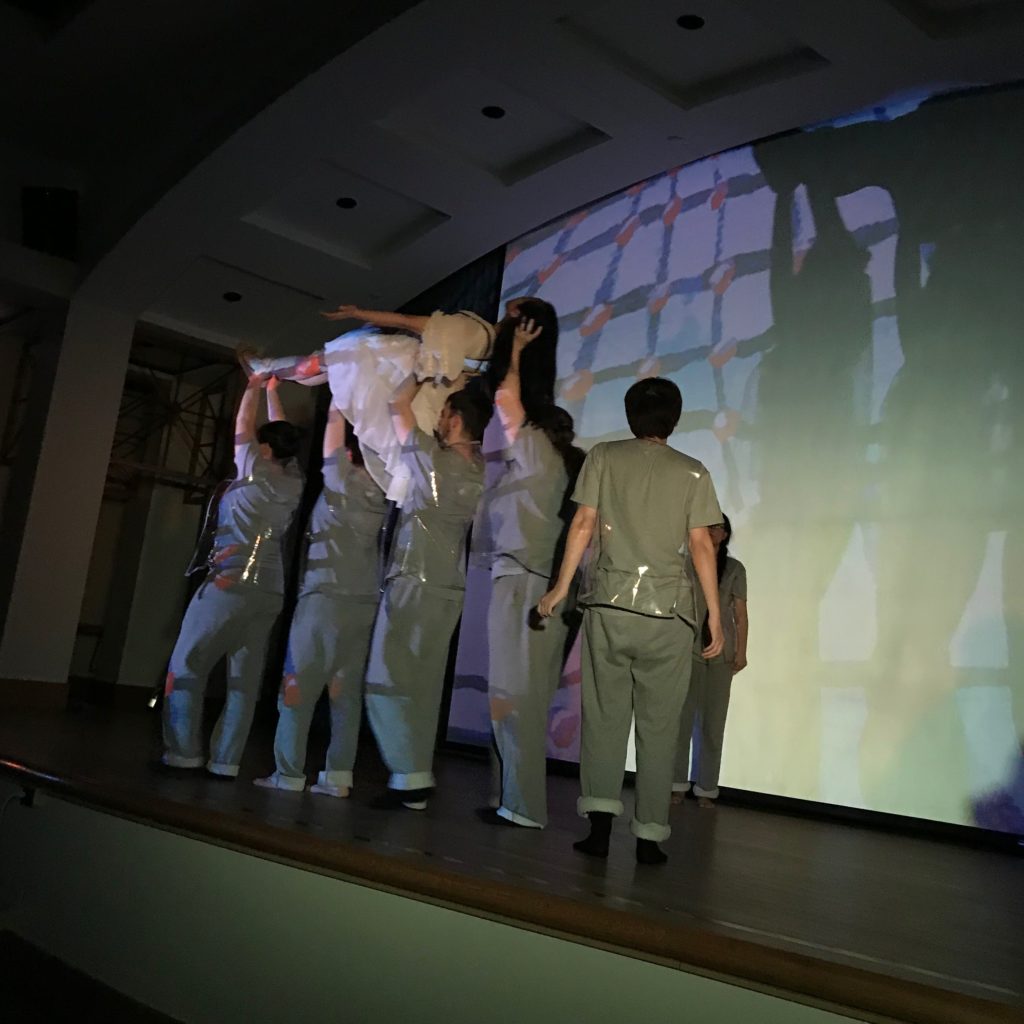
Terra is carried by the Quantum Ensemble following her collapse during the Bose-Einstein condensation dance
Echoes of the journey
I only worked on Quantum Voyages for one spring. By the time the show became a traveling production, I was inundated with PhD work (more quantum physics!) and the production grew enough to need a specialist for the role. However, I think of it often. I was not one of the physicists who found that they could act. I also did not contribute illustrations or music to it like some of my peers did. Nevertheless, Quantum Voyages pushed me to grow as a communicator.
Working on the MRI scene stands out in my memory. I remember getting a tour of an actual MRI machine and marveling at a paperclip that would levitate when released near its center, lifted by strong magnetic fields. Bright, Vishveshwara and I talked at length about what an MRI actually does. Magnetic fields inside the machine change the quantum mechanical character of every water molecule in the body of the patient. Can you feel that? Can you feel the molecules inside of you coordinate as if they could whisper to each other in a very accurate telephone game? I had taught undergraduate students about spins and magnets for years but never considered this.
In my teaching practice, I had been cautioned against using personifying language for physics concepts. Saying that an electron “wants something” or that an ideal gas “doesn’t know” goes under the name of pathetic fallacy. However, some days, when I feel particularly bold, I’ll channel the spirit of Quantum Voyages. I’ll say “ok, but can the atoms talk to the magnetic field here or not?” and wait for a student to tell me a story.
Everyone loves to learn from a story!
Note: prior to the COVID-19 pandemic, Quantum Voyages was scheduled to premiere its third iteration at University of California San Diego in May 2020




